RICE DISEASE- SYMPTOMS & MANAGEMENT
Diseases in Rice includes both in the nursery and in the main field. Here, all common diseases of Rice (Paddy) are summarized based on causing agents, damage symptoms and their management.
Nursery Disease
- Blast- Pyricularia grisea (P. oryzae)
- Bacterial Leaf Blight- Xanthomonas oryzae pv.oryzae
- Rice tungro disease- Rice tungro virus
Disease in main field
- Brown Spot- Helminthosporium oryzae
- Sheath Rot- Sarocladium oryzae
- Sheath Blight- Rhizoctonia Solani
- False Smut- Ustilaginoidea virens
- Grain discolouration– fungal complex
- Leaf streak– Xanthomonas oryzae pv. Oryzicola
Blast (P.oryzae)
Occurrence
- Areas with low soil moisture, frequent and prolonged periods of rain shower, and cool temperature in the daytime. In upland rice, large day-night temperature differences cause dew formation on leaves and overall cooler temperatures favor the development of the disease.
- Rice can have blast in all growth stages. However, leaf blast incidence tends to lessen as plants mature and develop adult plant resistance to the disease.
- Also known as rotten neck or rice fever.
- Expected grain loss : 70 to 80%
Damage symptoms
- Disease can infect paddy at all growth stages and all aerial parts of plant (Leaf, neck and node).
- In case of leaf blast, entire crop give a blasted or burnt appearance- hence the name “BLAST”
- Severe cases- lodging of crop (after ear emergence)
- When Neck region of panicle develops a black color and shrivels completely/partially grain set inhibited, called neck blast.
- In case of Nodal Blast, nodes become black and break up.
- Among the three leaves and neck infections are more severe.
- Small specks originate on leaves – subsequently enlarge into spindle shaped spots with ashy center.
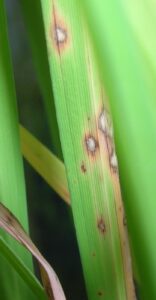
Management/Control
Cultural method
- Adjust planting time. Sow seeds early, when possible, after the onset of the rainy season.
- Remove collateral weed hosts from bunds and channels.
- Use only disease free seedlings.
- Avoid excess nitrogen. Apply N in three split doses (50% basal, 25% in tillering phase and 25% N in panicle initiation stage).
- Flood the field as often as possible.
Chemical Method
- Spray Carbendazim 50WP @ 500g/ha (or) Tricyclozole 75 WP @ 500g/ha (or) Metominostrobin 20 SC @ 500ml/ha (or) 47Azoxystrobin 25 SC @ 500 ml/ha.
Bacterial Leaf Blight (Xanthomonas oryzae pv. Oryzae)
Occurrence
- Most likely to develop in areas that have weeds and stubbles of infected plants.
- It can occur in both tropical and temperate environments, particularly in irrigated and rainfed lowland areas.
- The disease favors temperatures at 25−34°C, with relative humidity above 70%.
- It is commonly observed when strong winds and continuous heavy rains occur, allowing the disease-causing bacteria to easily spread through ooze droplets on lesions of infected plants.
Damage symptoms
- Seedling wilt or kresek.
- Water-soaked to yellowish stripes on leaf blades or starting at leaf tips then later increase in length and width with a wavy margin.
- Appearance of bacterial ooze that looks like a milky or opaque dewdrop on young lesions early in the morning.
- Lessions turn yellow to white as the disease advances.
- If the cuts end of leaf is kept in water it becomes turbid because of bacterial ooze.
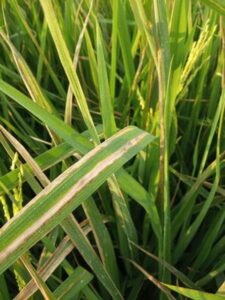
Management
- Best to use resistant varieties.
- Use balanced amounts of plant nutrients, especially nitrogen.
- Ensure good drainage of fields (in conventionally flooded crops) and nurseries.
- Keep fields clean. Remove weed hosts and plow under rice stubble, straw, rice ratoons and volunteer seedlings, which can serve as hosts of bacteria.
- Allow fallow fields to dry in order to suppress disease agents in the soil and plant residues.
- Spray fresh cowdung extract 20% twice (starting from initial appearance of the disease and another at fortnightly interval)
- Neem oil 60 EC 3% (or) NSKE 5% is recommended for the control of sheath rot, sheath blight, grain discolouration and bacterial blight.
Rice tungro disease (Rice tungro virus)
It is caused by the combination of two viruses, which are transmitted by leafhoppers. It causes leaf discoloration, stunted growth, reduced tiller numbers and sterile or partly filled grains.
Hence, it is important to notice the presence of leafhoppers. Check leaves for discoloration.
Damage symptoms
- Stunting, delayed flowering which may delay maturity, reduced number of tillers, small and not completely exerted panicles, as well as a higher than normal percentage of sterile panicles or partially filled grains, covered with dark brown blotches.
- Discoloration begins from leaf tip and extends down to the blade or the lower leaf portion
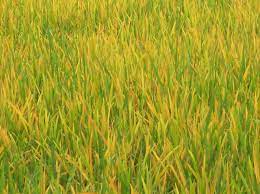
Management
- Grow resistant varieties.
- Practice synchronous planting with surrounding farms.
- Adjust planting times to when green leafhopper are not in season or abundant, if known Plow infected stubbles immediately after harvest to reduce inoculum sources and destroy the eggs and breeding sites of green leaf hopper.
- Light traps are to be set up to attract and control the leaf hopper vectors as well as to monitor the population.
- In the early morning, the population of leafhopper alighting near the light trap should be killed by spraying/dusting the insecticides. This should be practiced every day.
- Thiamethoxam 25 WDG 100g/ha or Imidacloprid 17.8 SL 100ml/ha at 15 and 30 days after transplanting. The vegetation on the bunds should also be sprayed with the insecticides.
Sheath Blight (Rhizoctonia solani)
Occurrence
- Occurs in areas with high temperature (28−32°C), high levels of nitrogen fertilizer, and relative humidity of crop canopy from 85−100%.
- Plants are more vulnerable to rainy season.
- High seeding rate or close plant spacing, dense canopy, disease in the soil, sclerotia floating on the water, and growing of high yielding improved varieties also favor disease development.
Damage symptoms
- Oval or ellipsoidal greenish gray lesions, usually 1-3 cm long, on the leaf sheath. Under favorable conditions, these initial lesions multiply and expand to the upper part of the sheaths, leaves, and then spread to neighboring tillers belonging to different hills (transplanted rice) or plants (direct-seeded rice).
- Lesions on the leaves usually have irregular lesions, often with gray-white centers and brown margins as they grow older.
- In subtropical environments, the disease is mostly initiated by sclerotia (up to two million of which can be produced per square meter in a diseased crop).
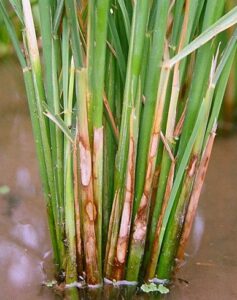
Management
- Use a reasonable level of fertilizer adapted to the cropping season.
- Use reasoned density of crop establishment (direct seeding or transplanting).
- Carefully control of weeds, especially on the levees.
- Drain rice fields relatively early in the cropping season to reduce sheath blight epidemics.
Cultural Method
- Apply Neem cake at 150 kg/ha. Foliar spray with Neem oil at 3% (15 lit /ha) starting from disease appearance
Chemical Method
- Carbendazim 50 WP @ 500g/ha
- Azoxystrobin @ 500ml/ha
- Hexaconazole 75% WG @ 100mg/ lit 1st spray at the time of disease appearance and 2nd spray 15 days later
Sheath Rot (Sarocladium oryzae)
Occurrence
- Particularly in rainfed rice ecosystems and is more prevalent during wet than dry seasons.
- It can also occur in areas with high amounts of nitrogen fertilizer application and high relative humidity and temperatures (20−28°C) at heading to mature crop stages.
Damage symptoms
- Irregular spots or lesions, with dark reddish brown margins and gray center. Lesions enlarge and often coalesce and may cover the entire leaf sheath.
- Discoloration in the flag leaf sheath.
- Severe infection causes entire or parts of young panicles to remain within the sheath
- Whitish powdery growth inside the affected sheaths and young panicles. Infected panicles sterile, shrivelled, or with partially filled grain.
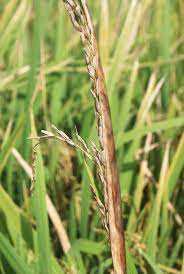
Management
Cultural Method
- Apply Gypsum @ 500 kg/ha at two equal splits once basally and another at active tillering stage.
- Botanicals Neem oil 3%
- Ipomoea leaf powder extract (25 kg/ha)
Chemical Method
- Carbendazim @ 500g/ha or Metominostrobin @ 500 ml/ha or Hexaconazole 75% WG @ 100 mg/ lit 1st spray at the time of disease appearance and 2nd spray 15 days later
Brown Spot (Helminthosporium oryzae)
Damage symptoms
- Also called as sesame leaf spot or Helminthosporiose or fungal blight.
- Occur in nursery as well as main field.
- Causes blight of seedlings.
- Leaf spotting is very common, Isolated brown, round to oval (resemble sesame seed).
- Seed also infected (black or brown spots on glumes spots are covered by olivaceous velvety growth).
- Infection also occurs on panicle neck with brown colour appearance.
- 50% yield reduction in severe cases.
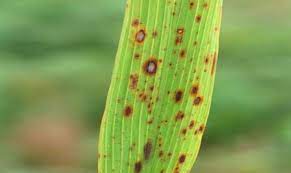
Management
Metominostrobin @ 500ml/ha
False Smut (Ustilaginoidea virens)
Damage symptoms
- Only few grains in a panicle are usually infected and the rest are normal.
- Individual rice grain transformed into a mass of yellow fruiting bodies.
- Growth of velvety spores that enclose floral parts.
- Immature spores slightly flattened, smooth, yellow, and covered by a membrane.
- Mature spores orange and turn yellowish green or greenish black.
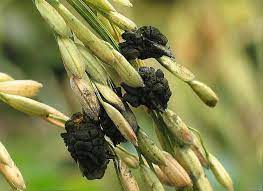
Management
- Two sprayings of Propiconazole 25 EC @ 500ml/ha (or) Copper hydroxide 77 WP @ 1.25 kg/ha at boot leaf and 50% flowering stages
Grain discoloration- fungal complex
Damage symptoms
- Drechslera oryzae, Curvularia lunata, Sarocladium oryzae, Phoma sp., Microdochium sp., Nigrosporasp. and Fusarium sp.,
- Grains are infected either after milk stage or after harvest or during storage.
- Infection cases discoluration of the glumes or kernels.
- Dark brown or black spots appear on grains.
- Under humid condition prominent fungal growth.
Management
- Spray Carbendazim + Thiram + Mancozeb (1:1:1) 0.2% at 50% flowering stage.
Leaf streak (Xanthomonas oryzae pv. Oryzicola)
- Initially, small, dark-green, water-soaked translucent streaks on veins from tillering to booting stage
- Lesions turn brown and bacteria ooze out under humid weather.
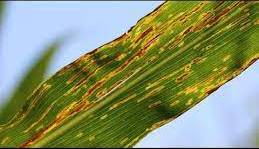
Management
- Spray fresh cowdung water extract 20%.
- Copper hydroxide 77 WP@1.25 kg/ha is also recommended.